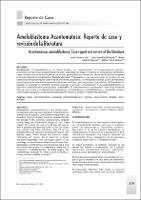| dc.contributor.author | Larios-León, Javier | |
| dc.contributor.author | Mansilla-Rodríguez, Juan | |
| dc.contributor.author | Cardeña-Mamani, Rakel | |
| dc.contributor.author | Flores-Alvarez, Willys | |
| dc.date.accessioned | 2023-06-01T17:53:42Z | |
| dc.date.available | 2023-06-01T17:53:42Z | |
| dc.date.issued | 2020-12-23 | |
| dc.identifier.citation | Revista del Cuerpo Médico Hospital Nacional Almanzor Aguinaga Asenjo. 2020:13(3). | es_PE |
| dc.identifier.issn | 2227-4731 | |
| dc.identifier.uri | https://hdl.handle.net/20.500.12959/3825 | |
| dc.description.abstract | Introducción. El ameloblastoma es un tumor benigno raro, ocasionalmente con comportamiento agresivo, proveniente de las células productoras de esmalte. Localizado con mayor frecuencia en la mandíbula, teniendo su mayor incidencia entre la 4ta 5ta década de la vida, generalmente asintomático, siendo los estudios de imágenes la prueba diagnóstica fundamental. Reporte del caso: Presentamos el caso de una mujer de 43 años con una tumoración en maxilar inferior izquierda de crecimiento progresivo, sin limitación funcional. La TAC de mandíbula muestra una lesión osteolítica y expansiva de bordes definidos, que rompe la cortical anterior infiltrando partes blandas; es sometida a extracción tumoral asociado a curetaje; conjuntamente en la anatomopatológica se identidica Ameloblastoma Acantomatoso. Conclusión: El ameloblastoma Acantomatoso tiene larga sobrevida libre de recurrencia si su diagnóstico es oportuno y su tratamiento es multidisciplinario, incluyendo cirugía y radioterapia, aunque su rareza ocasiona dificultad en encontrar el mejor tratamiento disponible. | es_PE |
| dc.description.abstract | Introduction. Ameloblastoma is a rare benign tumor,
occasionally with aggressive behavior, originating from
enamel-producing cells. Located most frequently in the
mandible, having its highest incidence between the 4th
5th decade of life, generally asymptomatic, imaging
studies being the fundamental diagnostic test. Case
report: We present the case of a 43-year-old woman
with a progressively growing tumor in the left lower
jaw, without functional limitation. The CT of the
mandible shows an osteolytic and expansive lesion with
defined edges, which breaks the anterior cortex,
infiltrating soft tissues; she is subjected to tumor
extraction associated with curettage; jointly in the
pathology, Acantomatous Ameloblastoma is identified.
Conclusion: Acantomatous ameloblastoma has a long
recurrence-free survival if its diagnosis is timely and its
treatment is multidisciplinary, including surgery and
radiotherapy, although its rarity causes difficulty in
finding the best available treatment. | es_PE |
| dc.format | application/pdf | es_PE |
| dc.language.iso | spa | es_PE |
| dc.publisher | Seguro Social de Salud (EsSalud) | es_PE |
| dc.relation.uri | http://cmhnaaa.org.pe/ojs/index.php/rcmhnaaa/article/view/748 | es_PE |
| dc.rights | info:eu-repo/semantics/openAccess | es_PE |
| dc.rights.uri | https://creativecommons.org/licenses/by-nc-sa/4.0/ | es_PE |
| dc.subject | Eameloblastoma | es_PE |
| dc.subject | Neoplasias maxilomandibulares | es_PE |
| dc.subject | Tumores odontogénicos | es_PE |
| dc.subject | Ameloblastoma | es_PE |
| dc.subject | Maxillomandibular neoplasms | es_PE |
| dc.subject | Odontogenic tumors | es_PE |
| dc.title | Ameloblastoma Acantomatoso: Reporte de caso y revisión de la literatura | es_PE |
| dc.title.alternative | Acantomatous ameloblastoma: Case report and review of the literature | es_PE |
| dc.type | info:eu-repo/semantics/article | es_PE |
| dc.subject.ocde | https://purl.org/pe-repo/ocde/ford#3.02.21 | es_PE |
| dc.identifier.doi | https://doi.org/10.35434/rcmhnaaa.2020.133.748 | |






